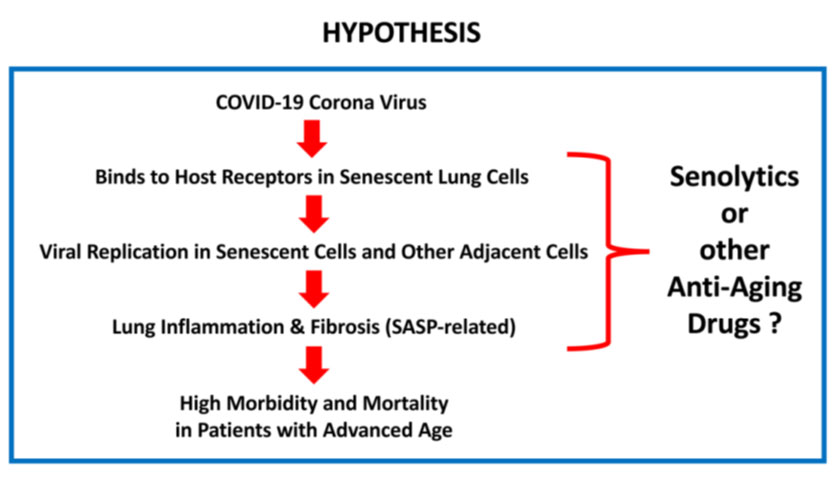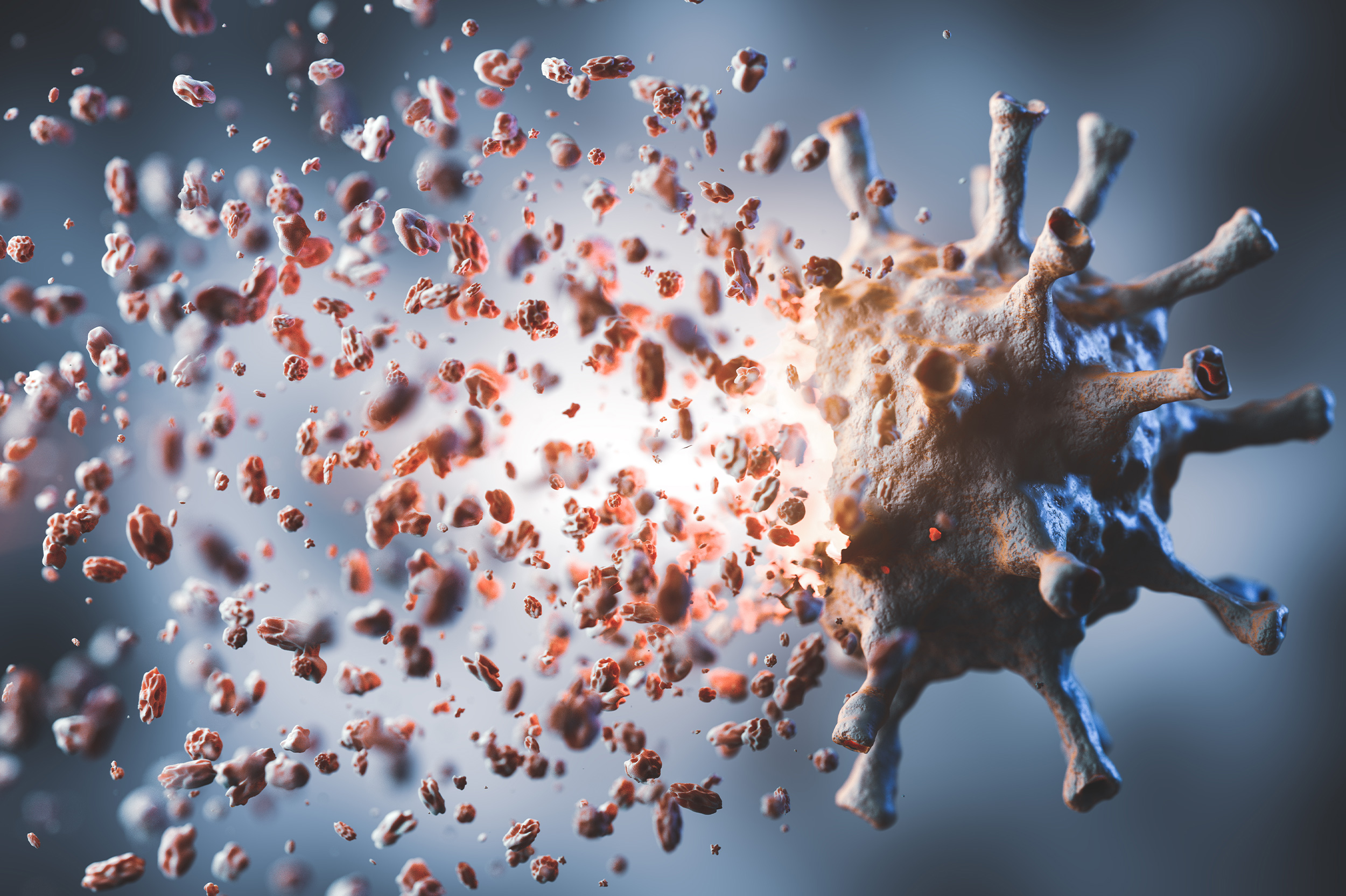Table of Contents
Putting aside all personal opinions and emotions about COVID-19, being a researcher in the field of aging, the scientific article by Sargiacomo et al., 2020; “COVID-19 and chronological aging: senolytics and other anti-aging drugs for the treatment or prevention of corona virus infection?” definitely caught my attention! This article was aimed towards the scientific community, raising awareness towards the idea of anti-aging/senolytic drugs in the treatment of what seems to be our current nemesis, COVID-19. This article will explore the idea of anti-aging compounds as a prevention for illness, including COVID-19.
What Are Anti-Aging and/or Senolytic Drugs?
Before I jump into the details of this article, I will first start by defining as best as I could, some scientific jargon, so as not to lose you prior to the juicy findings! Anti-aging drugs are exactly what the name implies; drugs that inhibit specific processes of aging. The interesting part of these chemical compounds is that some of these drugs are isolated compounds from natural sources! You’ve probably heard of some of these before – resveratrol, spermidine, caffeine, etc. More information can be found on some of these naturally occurring compounds in the Vitoli blog:
- Resveratrol: how to respond to the risk of death!
- Olive polyphenols and vitoli products – article 1: primary aging
- Olive polyphenols and vitoli products – article 2: the benefits
- Olive polyphenols protect against aging (article 1 of 2)
- Olive polyphenols can increase life expectancy? (article 2 of 2)
Senolytic drugs are somewhat anti-aging, in that they specifically target senescent cells (cells that no longer divide and are not as functional as they used to be) and make sure they are properly disposed of (apoptosis – programmed cell death, along with other cellular maintenance programs).
When Can Senescent Cells Pose a Threat?
Apoptosis (programmed cell death) is a very efficient maintenance program in organisms like ourselves, that much like the natural wear and tear of any machine, removes the rusted or broken nuts and bolts before they pose an issue on the machine altogether. Cells have their very own life span and cycle/phases. In a fully functional system, when there is a dysfunction, maintenance programs target these cells, stop them from dividing/replicating, and dispose of them accordingly.
When cells exit their growth cycle and stop dividing, they are called quiescent cells. The quiescent cell state is a great area of interest for anti-aging research. It is here that cells can assess environmental information and adapt accordingly for survival and re-enter the cycle to divide/replicate based on an adaptation to a specific stress (including aging). Although this information is not relevant to this particular article, it will most definitely be topic that will later be covered within the Vitoli blog. I nonetheless feel that this is a piece of information that should be mentioned when explaining a cell’s life cycle/phases, because it is an aspect that researchers are working on towards longevity medicine.
Senescent cells that permanently leave the cell cycle (unlike quiescent cells), are biologically stopped in order to limit dysfunctional/cancerous growth. Due to certain factors, sometimes the biological maintenance systems dispose of them and sometimes they are simply left unattended. These cells naturally accumulate throughout the aging process, therefore, the older you are, the more senescent cells you have. Although senescent cells have their role, the unfortunate issue is that as senescent cells accumulate within the body, “with age leads to increased inflammation due to a senescence associated secretory phenotype (SASP). This phenotype that includes many cytokines promotes tumorigenesis and can exhaust the pool of immune cells in the body.” (Thoppil & Riabowol, 2020). Therefore, if the maintenance mechanisms are not discarding these cells accordingly, and if these cells decide to over-produce and accumulate, immune cells decline and henceforth the body will be more susceptible to many illnesses.
What Is Chronological-Aging and Why Focus on It?
Due to the fact that the coronavirus is most likely contracted by the elderly population, these scientists chose to hone-in specifically on the association of COVID-19 and human chronological aging (scientific term used to define age, in this case for humans, since date of birth). Through their findings from the statistics provided by the CDC in the United States in March of 2020, those aged 85 or more had the highest mortality rates (10-27%), which declined with each declining chronological age bracket. Since the more advanced aged populations are more susceptible to contraction and mortality from this virus, then there may be a direct association to a specific mechanism or pathway preferred by the virus on advanced aged populations. Which, in hindsight, seems like a question we should have all asked, given the information we all knew, merely by listening to the news!
What Are the Mechanisms of Action of COVID-19?
Since the more advanced aging population is more likely to have a larger number of senescent cells (as mentioned previously), the researchers proposed that the virus may be acting on these mechanisms. Although more research is yet to be done on the specifics behind COVID-19 and its mechanisms of action, the authors of the article observed that COVID-19 mainly acts on two major receptors; that of CD26 and ACE-2 (angiotensin-converting enzyme 2). Interestingly enough, “both CD26 and the angiotensin system show associations with senescence.” (Sargiacomo et al., 2020).
Sargiacomo and associates suggest that senolytic drugs like chloroquine and its derivates (such as Hydroxychloroquine and Azithromycin) can act on senescence through the SASP pathway of COVID-19 in the way that it does for other viruses and illnesses (Zika, Ebola, Cystic Fibrosis, Sjogren’s syndrome, etc.). Given the history of these drugs for other viruses and illnesses, there is much potential, yet much more research ahead in order to determine the most optimal solution.
Their research has also suggested that Quercetin has senolytic properties as well. Quercetin has been found to inhibit the initial attachment of the virus on senescent cells with the help of the ACE-2 receptor (Smith et al., 2020). What makes quercetin so interesting is that it can be derived naturally through readily available food sources. This means that your senolytic helper against the virus could very well be in your refrigerator or pantry as we speak!
To learn more about quercetin and its many natural food sources, QUERCETIN AND CORONAVIRUS: EAT IT IF YOU ARE INTERESTED! is a great article to start off with! Be sure to also look at GREEN TEA SOUP, WITH TURKEY AND VEGETABLES RICH IN QUERCETIN for a fun home recipe that integrates quercetin naturally into the diet!
The Hypothesis
From the results observed, Sargiacomo and associates proposed the hypothesis that COVID-19 targets and infects senescent lung cells (which are abundant in our aging populations), will replicate and cause SASP-related inflammation (previously mentioned), that will ultimately compromise the immune system. Therefore, what they proposed is that senolytics or other anti-aging drugs can activate the apoptosis and maintenance mechanisms so that the senescent cells are disposed of prior to or even during infection, thereby containing internal spread of the virus and increasing immune potential. How amazing is that?! Unfortunately, more research is yet to be done, as well as case studies, in order to transform this hypothesis into something more conclusive.

(Sargiacomo et al., 2020)
The Implications and/or Impact of Natural Compounds and Anti-Aging Drugs as a Prevention
In summary, anti-aging compounds have much potential in a multitude of domains other than that of longevity. Although more research must still be done, the premise of some hypotheses and results from current findings lay the groundwork for an optimistic future. The important factor that I would like to highlight from this article amongst the ample research currently underway, is that there is a possibility that certain senolytic/anti-aging drugs that have worked for viruses in the past may very well work for this virus as well. Another point I would like to highlight is the potential of senolytic and anti-aging natural and/or traditional medicines within this field of study! For more information on other research papers concerning natural products and the coronavirus, I invite you to read up on the article from the Vitoli blog: Coronavirus and natural products; a hope for new antivirals.
My personal advice towards a preventive measure to increase the immunity against the virus is simple: have a balanced and healthy diet (one that preferably contains natural anti-aging compounds and superfoods), proper exercise, keep a positive and grateful attitude, and find ways to decrease chronic stress that best fits your lifestyle. We are all in this together, and we will hopefully see the light at the end of this treacherous tunnel very soon!
I hope you enjoyed this article and I look forward to writing more on other relevant health topics! Feel free to message us with any comments or enquiries you may have.
Other suggested items:
- My mother and SARS-Cov-2
- An excellent virus
- The Empire strikes back
- I have a dream…
- From Aristotle to Covid-19
- The chimera and the virus… or the origin of SARS-Cov-2
Références:
- Sargiacomo C, Sotgia F, Lisanti MP. COVID-19 and chronological aging: senolytics and other anti-aging drugs for the treatment or prevention of corona virus infection?. Aging (Albany NY). 2020;12(8):6511-6517. doi:10.18632/aging.103001
- Thoppil H, Riabowol K. Senolytics: A Translational Bridge Between Cellular Senescence and Organismal Aging. Front Cell Dev Biol. 2020;7:367. Published 2020 Jan 22. doi:10.3389/fcell.2019.00367
- National Center for Biotechnology Information (2020). PubChem Compound Summary for CID 2719, Chloroquine. Retrieved August 12, 2020 from https://pubchem.ncbi.nlm.nih.gov/compound/Chloroquine.
- van Deursen JM. The role of senescent cells in ageing. Nature. 2014;509(7501):439-446. doi:10.1038/nature13193
- Fontana L, Partridge L, Longo VD. Extending healthy life span–from yeast to humans. Science. 2010;328(5976):321-326. doi:10.1126/science.1172539
- Hansel C, Jendrossek V, Klein D. Cellular Senescence in the Lung: The Central Role of Senescent Epithelial Cells. Int J Mol Sci. 2020;21(9):3279. Published 2020 May 6. doi:10.3390/ijms21093279
- Burton DG, Krizhanovsky V. Physiological and pathological consequences of cellular senescence. Cell Mol Life Sci. 2014;71(22):4373-4386. doi:10.1007/s00018-014-1691-3
- Mani JS, Johnson JB, Steel JC, et al. Natural product-derived phytochemicals as potential agents against coronaviruses: A review. Virus Res. 2020;284:197989. doi:10.1016/j.virusres.2020.197989
- Gorrell MD, Gysbers V, McCaughan GW. CD26: a multifunctional integral membrane and secreted protein of activated lymphocytes. Scandinavian Journal of Immunology. 2001 Sep;54(3):249-264. DOI: 10.1046/j.1365-3083.2001.00984.x.
- Tanaka T, Narazaki M, Kishimoto T. IL-6 in inflammation, immunity, and disease. Cold Spring Harb Perspect Biol. 2014;6(10):a016295. Published 2014 Sep 4. doi:10.1101/cshperspect.a016295






